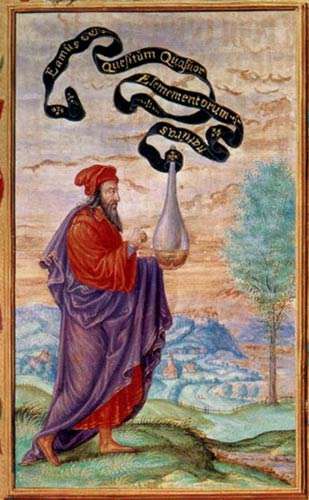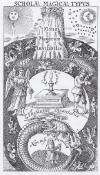The Essential Key of the Great Work
What is Hermetic Alchemy or the Alchemy of the
Philosophers? It is the transmutation, or transformation of the common
man into the divine man. The common man is the person we know from our
every day lives. He grew up in our society as an ordinary person,
unaware of who he really is. The transmutation consists of becoming
aware of the different aspects of his being: the physical body and its
energies, emotions, thoughts and his divine center, and of purifying
body, emotions and thoughts. This purification process will allow his
divine center to shine through all these layers and become fully
manifest in physical reality. It is the realization of our divine
essence. Common man is like being asleep, the realized man is like being
fully awake. It is all about clarity of awareness. The alchemists called
it the Great Work.
This is the entire secret of the Great Work. It is
very simple. The uninitiated, who is unaware of the different aspects of
the human being, might have difficulty to understand this
transformational process, and thus the alchemists gave us explanations
in symbolical language. Chemical terms were not the only way they tried
to explain what is about. Some concepts are more easily transferred by
means of images, and thus the student of alchemy has to study the
drawings and paintings by not only deciphering their symbolic
interpretations, but also by feeling them. One could say that the
student makes a psychic connection with the archetypes of these images.
The alchemists also made use of allegoric scenes derived from Greek
mythology. Therefore one must know the mythological stories in order to
understand their meaning for the inner transformational processes.

The essence of the Great Work is plain and simple: the purification of
your awareness. The alchemical images show that the Great Work is a
personal and spiritual process, and not laboratory chemistry. Elsewhere
in this website you can find another article
of mine about a psychological interpretation of alchemy. It gives you a
good idea about the psychological aspects of the Great Work. In this
article I am going to explain you the spiritual practice of alchemy. As
I mentioned earlier there are many spiritual practices around, and you
can choose one that you feel comfortable with. But the basis of
purification of yourself always remains the same. The basis of all
spiritual practices is the elimination of unwanted emotions and
thoughts. Without this any practice will fail. The more you practice,
the clearer your mind becomes, the sharper your awareness, the more the
light of your divine self will shine through.
I started meditating
when I was about 20 years old. I had read a book by Maharishi Mahesh
Yogi, the founder of transcendental yoga. In it he recommended a
meditation technique in which you focus on visualizing an object like a
match, in order to become aware of thoughts, how thoughts arise and
disappear, and to be eventually without thoughts. I tried to visualize a
match but discovered I just couldn't do it. It was frustrating. So I
decided to drop this visualization and just eliminate my thoughts. That
is of course easier said than done. I chose the forceful way, that is,
every time a thought would come up, I immediately made a big effort to
stop it. Many years later I learned from studying Buddhist meditation
techniques that this is actually the most difficult way in thought-less
meditation. Usually they advise to go at it in a much more gently way.
But it worked for me. Let me also that that aside from that one book of
the Maharishi I did not know anything about meditation techniques or
Buddhist teachings. I did it all by intuition. Much later I learned that
what I was doing was actually called Dzogchen.
Thus I became aware
of my inner world of thoughts. I discovered that thoughts are constantly
running through the mind, every second of the day. They just ramble on,
about anything possible. During meditation, when you direct attention
inwards, you really become aware of all these thought-trains. They
usually work by association, jumping from one subject to another. The
trick is to stop their flow. I did it by stopping every upcoming thought
in its tracks. Usually Buddhists will advise you to just observe the
thoughts indifferently and let them pass by, not putting any energy in
it, not jumping on the train by way of speaking. But I wanted to stop
them right away. First I discovered that as soon as I eliminated one
thought, another popped up right away. Often my attention would weaken,
and I would not be aware that I was going along with a thought-train,
that is actively thinking about a certain subject. Then I would become
aware again, and stop this thought-train too. You can't imagine how many
thoughts arise in a half hour of meditation! But with the days and weeks
you get better at it. I found out that there are different layers of
thoughts. At the surface are thoughts about anything that happened to
you in the recent past, things that you said to someone, and things that
want to say to someone. They are basically all just ramblings. When you
are able to eliminate these, you see thoughts about more profound
subjects, more serious things about your life. The more you eliminate
thoughts the more basic they become. The whole process is about becoming
aware of them and eliminating them, or observing them in an unattached
way.
All this demands one thing that is indispensable: absolute
clear awareness. The more you think, that is, the random thoughts, the
more unaware you are of your self. In meditation you have to make an
effort to be aware, to be conscious, of your thoughts, and to keep this
awareness going. That is not easy because we all have the tendency to
slip back in our every day dreamy state of consciousness. The biggest
obstacle in any kind of meditation is this slipping back in dreamy
consciousness, and even falling asleep. It helps to use deep breathing
to maintain the clarity of your mind and to prevent the sliding off in
unawareness. All those random thoughts we don't really need, and they
are an obstacle for our true divine essence. The purpose of meditation
is not so much to be without thoughts, but to become clear aware of our
Self. It is something that is not easily put in words. When you direct
your attention inwards, you will discover that you have an inner world,
where emotions and thoughts reside. But these are just energies of your
present personality. You will also become aware of your real self. That
is vague at the beginning but it becomes clearer the more you can purify
your awareness.
So I was eliminating my thoughts. After about two
years of daily meditation, I was able to have about only ten thoughts in
half an hour. I was using a rope with ten knots to keep track of them.
It is really invigorating when your energy is not used up by a constant
thinking process. I was also trying to have at least thoughts as
possible during the day during periods when I was by myself. I generated
so much energy that I sometimes had to stop with it because it was
difficult to handle.
Then one day, after half or an hour of
meditation, I was in a state without any thoughts. It is not easy to put
in words, but here we go. I was absolutely in the here and now, wherever
that is, because there was no awareness of the body. I was completely in
my self. Being my self. Pure being me. It was a state that felt very
good, very pleasant, but not inn an emotional way. There was no
darkness, as when you close your eyes and you start to meditate. There
is also no shining light as some people might expect, but it is like a
light state of being, if that makes any sense to you. Some people say
that when you are aware that you have no thoughts, that this also a
thought, claiming that we cannot be completely without thoughts. I
disagree. The state I was in was in was absolutely "above" thoughts.
There was no awareness that I was not thinking anymore. Even that was
gone. It is just pure being my self. There is not much you can say about
it in words.
It was many years later that I found out that this is
half-way the ultimate goal of what is called enlightenment. Let me
clarify here that enlightenment is just becoming aware of your true
divine self that is always there but is obscured by our thoughts,
emotions, our physical body. It not some out-there, wow, amazing
experience. What you truly are, your divine self, is just plain and
simple pure awareness of your being. Nothing extraordinary. Attaining
your pure state of being, in pure awareness, is not enough. One has to
be able to maintain it. First, longer and longer during the meditation
session, and then ultimately one must keep this pure awareness when one
comes out of the meditation and back into everyday life. And longer and
longer too in every day life. Until the pure awareness of your divine
self will be constant. That is true enlightenment.
I was only able
to maintain the pure awareness for a couple of minutes. At that of my
life, I had no idea what this state of being really was about. So, after
a while I abandoned my meditation practice. Many years later I started
reading Buddhist literature and found out more about it. Now I also see
the parallel with alchemical symbolism. There are many spiritual
practices but they all have the same basic outline. In general terms:
the first stage is Nigredo or blackness, when one becomes initially
aware of one's tumultuous emotions and random thoughts. Albedo
Whiteness, which is the state of pure awareness of oneself, and Rubedo
of redness, when this pure awareness has become permanent. In alchemical
terms I had reached the stage of Albedo. Unfortunately, at that point in
my life, I didn't quite understand what I have reached. I was able to
reach the same state of being several times, I eventually stopped with
meditation for a while, and since then I haven't been able to reach it
again. Life has taken me on other paths and other responsibilities. It
really takes discipline in order to get results, and living in a society
does not make that easy. I can easily see why monasteries and caves are
ideal places for meditation practices, but solitude is not necessarily a
requirement either..
If you keep this all in mind, the following
alchemical images and symbols becomes so much more understandable. The
purpose of showing you alchemical images here is twofold. First, a basic
interpretation of the symbols and allegories is necessary to gain an
understanding of the alchemical process. Second, look and meditate on
the image itself and try to get a feel of what it is communicating.
Images allow you to come into contact with the energy of what it
represents. When humans form an image, be it in the mind, or on paper,
or engage in a practice, a morphogenetic field is formed that carries
information about that particular subject or practice. The more people
who are engaged in that practice, or have used those images to form
their concepts or understanding, the more that energy field gets charged
and laden with information. Because everything in the universe is alive,
from rocks, minerals, to plants, animals humans and other beings, these
particular morphogenetic fields are also alive and continue to exist. by
focusing on images one connects with these energy fields, and their
information will flow into your mind. It can be very subtle or very
clear depending on your sensitivity, but this way you can gain
understanding in a very direct way. it is like intuition and
inspiration. It flows into you, you suddenly know and understand,
without words, although your mind might translate it into thoughts.
Thus, really pay attention to the images and let them speak to you too.
Some advice if you want to practice spiritual alchemy. It is a life
style. It is a transformation of your entire being. It is not only about
that half hour of meditation. You have to change your attitude, your
action, your emotions, your diet, the company your in, your environment,
because all this will affect the efficacy of your meditation. It is not
the place here to explain all the different things you have to change in
your life, you can find that well described in the Buddhist teachings,
but also study other teachings like Gnosticism, mystical Christian
teachings, theosophy, Rosicrucianism etc. You can also the many articles
I have put up in the section of The House of the Sun of our web site.
Choose a meditation practice that suits you. Buddhism explains several
kinds of meditation techniques. The basis all all Buddhist techniques is
Dzogchen. Without the understanding of Dzogchen no meditation technique
will bear fruit. Dzogchen explains how to reduce unwanted thoughts or
eliminate them all together. There are now several books of Dzogchen on
the market. The best one, in my opinion is The Crystal and the Way of
Light: Sutra, Tantra and Dzogchen by Chogyal Namkhai Norbu. It is not
necessary to eliminate all thoughts, but to arrive at that state of
clear awareness where there are no random thoughts, where if you want to
think, you can initiate thoughts when you really want to. In other
words, you control the thoughts, instead of the thoughts controlling
you.
Just when I had finished this article, I found a nice link
between alchemy and the eastern practices of meditation in lama
Anagarika Govinda's book Foundations of Tibetan Mysticism: "The Buddha
alludes to the same state (the state of Enlightenment (or sambodhi),
when saying in Udana VIII: 'Verily there is a realm, where there is
neither the solid nor the fluid, neither heat nor motion, neither this
world nor any other world, neither sun nor moon... There is o, monks, an
Unbornn, Unoriginated, Uncreated, Unformed. If there were not this
Unborn, this Unoriginated, this Uncreated, this Unformed, escape from
the world of the born, the originated, the created, the formed, would
not be possible..'
"He who has realized this, has truly found the
Philosopher's Stone/ the precious jewel (mani), the prima materia of the
human mind, nay, of the very faculty of consciousness in whatever form
of life it might appear. This was the real aim of all great alchemists,
who knew that 'mercury' stood for the creative forces of higher
consciousness, which had to be freed from the gross elements of matter
in order to attain the state of perfect purity and radiance, the state
of enlightenment."
 |
 |
 |
 |
 |